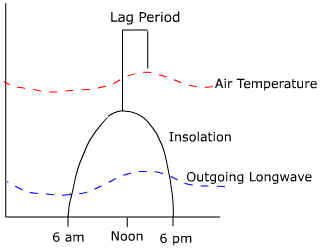Controls over air temperatureTemperature is a measure of the heat content of a body. It is a measure of the average speed of the random motion of molecules that comprise a substance. The air temperature at any place is determined by (1) radiation and heat transfers between the surface and the air above, (2) the location relative to a large body of water, and (3) the movement of vast pools of air called air masses. Radiation, sensible heat and temperatureThe air temperature at a place is determined by the exchange of radiant energy between the Sun, Earth, and its atmosphere. Solar radiation is the principle source of energy to heat the surface. Shortwave solar radiation easily penetrates to the surface without much absorption by the gases that comprise the atmosphere. As the sun heats the surface during the day, the earth warms and increases its output of infra red, or longwave radiation. The gases of the atmosphere, being relatively good absorbers of longwave radiation, are warmed and experience a rise in temperature. Thus, the immediate source of energy to heat the air is the surface of the earth. The daily cycle of radiation and air temperature is shown in Figure 5.3.
Solar radiation increases after sunrise to a maximum at noon and then decreases to a minimum at sunset. Outgoing radiation increases after sunrise but lags somewhat behind the insolation curve. The graph for air temperature follows the same pattern as that of outgoing radiation. This should seem reasonable as it is the absorption of outgoing energy from the surface that determines air temperature. The amount of time between maximum incoming energy and maximum temperature over the day is known as the daily temperature lag. |
